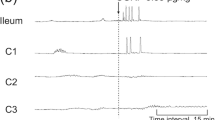Abstract
Proglumide (0.02 mg/kg), a cholecystokinin antagonist, was administered to rats either together with or without morphine (0, 5, 15, or 45 mg/kg). Whereas proglumide in the absence of morphine showed a trend towards enhanced behavioral activation, it potentiated the hy[okinesia induced by morphine. These results are consistent with the hypothesis that endogenous cholecystokinin tonically antagonizes opiate modulation of motility, irrespective of whether such modulation is produced by opiates and endogenous or exogenous origin.
Similar content being viewed by others
References
Faris PL, Komisaruk BR, Watkins LR, Mayer DJ (1983) Evidence for the neuropeptide cholecystokinin as an antagonist opiate analgesia. Science 219:310–312
Hahne WF, Jensen RT, Lemp GF, Gardner JD (1981) Proglumide and benzotript: members of a different class of cholecystokinin receptor antagonists. Proc Natl Acad Sci USA 78:6304–6308
Havemann U, Kuschinsky K (1982) Neurochemical aspects of the opioid-induced ‘catatonia’. Neurochem Int 4:199–215
Itoh S, Katsuura G (1981) Suppressive effect of cholecystokinin and its related peptides on β-endorphin-induced catalepsy in rats. Eur J Pharmacol 74:381–384
Jurna I, Zetler G (1981) Antinociceptive effect of centrally administered caerulin and cholecystokinin octapeptide (CCK-8). Eur J Pharmacol 73:323–331
Katz RJ (1979) Naltrexone antagonism of exploration in the rat. Int J Neurosci 9:49–51
Kinscheck IB, Watkins LR, Kaufman E, Mayer DJ (1983) Evidence for a cholecystokinin (CCK)-like endogenous opiate antagonist. Soc Neurosci Abstr 9:792
Morley JE (1982) The ascent of cholecystokinin (CCK) — from gut to brain. Life Sci 30:479–493
Stinus L, Koob GF, Ling N, Bloom FE, Le Moal M (1980) Locomotor activation induced by infusion of endorphins into the ventral tegmental area: evidence for opiate-dopamine interactions. Proc Natl Acad Sci USA 77:2323–2327
Tang J, Chou J, Iadarola MJ, Yang H-YT, Costa E (1983) Possible participation of endogenous cholecystokinin 8 (CCK) in the tolerance to morphine analgesia in the rat. Soc Neurosci Abstr 9:288
Urca G, Frenk H (1980) Pro- and anticonvulsant action of morphine in rats. Pharmacol Biochem Behav 13:343–347
Watkins LR, Mayer DJ (1982) The neural organization of endogenous opiate and nonopiate pain control systems. Science 216:1185–1191
Winer BJ (1971) Statistical principles in experimental design. McGraw-Hill Book Company, New York
Zetler G (1981) Central depressant effects of caerulin and cholecystokinin octapeptide (CCK-8) differ from those of diazepam and haloperidol. Neuropharmacology 20:277–283
Author information
Authors and Affiliations
Rights and permissions
About this article
Cite this article
Ben-Horin, N., Ben-Horin, E. & Frenk, H. The effects of proglumide on morphine induced motility changes. Psychopharmacology 84, 541–543 (1984). https://doi.org/10.1007/BF00431463
Received:
Accepted:
Issue Date:
DOI: https://doi.org/10.1007/BF00431463




